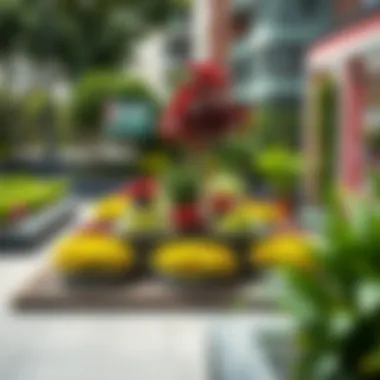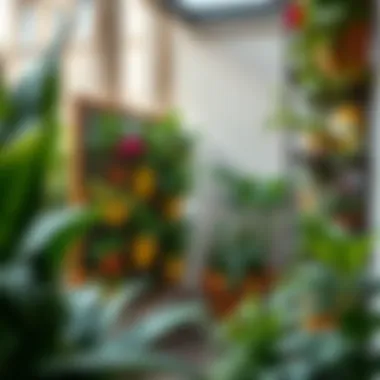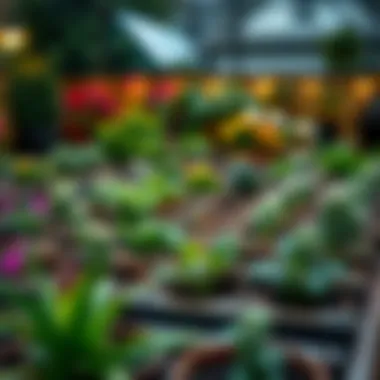Maximizing Bedspace in Urban Gardens: A Guide


Intro
In the bustling urban environment, where space is often at a premium, gardens serve as crucial sanctuaries. The different ways of arranging these patches of greenery can significantly impact not only aesthetic appeal but also functionality. As cities like Dubai continue to expand, the need for optimizing bedspace in gardens becomes more pronounced. This comprehensive guide will navigate through the essential strategies, innovative designs, and sustainable practices, ensuring that even the smallest of gardens can thrive and flourish.
Understanding the intricate dynamics of garden bedspace management isn't just for gardening enthusiasts. Investors, real estate agents, and expatriates must grasp these concepts to align their interests with market trends, enhancing property values while promoting sustainable living. Today’s garden owner is looking beyond mere decoration; they want gardens that provide solace, environmental benefits, and even contribute to local biodiversity.
This guide aims to offer a rich tapestry of information, helping you unlock the potential of every square inch. Let's embark on a journey through the crucial aspects of bedspace optimization, grounded in practical insights and innovative principles.
Foreword to Garden Bedspace
Understanding bedspace in gardens is not just an aesthetic endeavor, but a crucial element in maximizing the functionality and appeal of urban landscapes. As urbanization continues to reshape our surroundings, the efficient use of limited garden space becomes ever more significant. The concept of bedspace pertains to the layout and organization of planting areas—ultimately influencing growth, health, and the visual charm of the garden.
Definition and Importance
Bedspace refers to the amount of area allocated for plants within a garden setting. This element is pivotal as it directly affects both the capacity for diverse plant growth and the overall functionality of an outdoor area. When gardens are well-designed with optimized bedspace, they can serve multiple purposes: from producing food to providing a serene environment to unwind, often melding utility with beauty.
Having an organized bedspace can lead to improved yields in vegetable gardens, enhanced biodiversity with proper plant selection, and healthier ecosystems by allowing for adequate airflow and sun exposure. This, in turn, makes nurturing plants more manageable and efficient.
Moreover, when investors or expatriates consider properties in areas like Dubai—where outdoor space may be at a premium—the arrangement and optimization of garden bedspace could significantly impact property value. Each square foot must be utilized wisely, showcasing the garden not merely as an external feature but as an integral aspect of the property's allure.
Historical Context of Garden Design
Historically, the design of garden bedspaces has evolved alongside human civilization. From the ancient hanging gardens of Babylon to the geometric patterns seen in Islamic gardens, cultures have always sought to create spaces that are both functional and reflective of their values.
In medieval Europe, for instance, gardens were often organized around a central point, emphasizing symmetry and balance. Eventually, as gardening techniques advanced, the rise of concepts like permaculture began to change perceptions about how bedspaces should be utilized. The modern approach now encourages companion planting—where certain plants thrive better when grown together—which highlights progress from traditional layouts towards more scientific and sustainable practices.
These shifts in gardening techniques show an evolving understanding of how to optimize space while respecting nature. The transition from mere aesthetics to focusing on ecological balance addresses the needs of urban settings today, making it imperative for contemporary gardens to draw inspiration from this rich tapestry of garden design history.
Bedspace Types and Models
The layout and design of a garden's bedspace are pivotal to its overall success. Each type of bedspace offers distinct advantages, allowing gardeners to tailor their approach to specific constraints and goals. Factors such as space availability, soil conditions, and personal preferences all influence the choice of bedspace model. In urban environments like Dubai, where land is at a premium, understanding the various bedspace types is essential to maximizing both functionality and aesthetics.
Raised Bed Gardens
Raised bed gardens are an increasingly popular choice among gardeners who want to control soil quality and improve drainage. These structures elevate the planting area, often using timber or stone, which helps to keep pests at bay and offers a more comfortable working height for planting and harvesting.
One of the primary benefits of raised beds is their capacity to heat up faster in spring, leading to earlier planting opportunities. For cities with a short growing season, this can make a significant difference. Additionally, the soil in raised beds warms quicker, which can lead to better root development and ultimately higher yields.
- Benefits of Raised Bed Gardens:
- More control over soil quality and drainage.
- Easier access for planting and maintenance.
- Extended growing season.
However, there are also considerations to keep in mind. Building raised beds requires upfront investment in materials and can also necessitate additional watering, as they tend to dry out quicker than in-ground beds. Placement is key; these beds should be in a location that receives ample sunlight while being protected from harsh winds.
In-Ground Bedspaces
In-ground bedspaces, as the name suggests, involve planting directly into the existing soil of the garden. This method can be highly effective, particularly when the native soil is fertile and well-drained. One can amend the existing soil to improve its quality by adding compost or other organic materials, enriching it for optimal plant growth.
A significant advantage of this approach is the lower material cost—there’s no need for construction materials as required for raised beds. Another point in favor of in-ground beds is stability; unlike raised structures, which can shift and settle over time, in-ground beds benefit from the natural stability of the earth.
- Considerations for In-Ground Bedspaces:
- Soil quality can vary, necessitating amendments.
- More challenging to maintain weed control compared to raised beds.
Nonetheless, gardeners in urban areas must consider potential soil contaminants, especially in densely populated spaces. It’s often recommended to conduct soil tests to ensure that the planting area supports healthy plant growth without introducing harmful toxins.
Container Gardening
Container gardening is an ideal solution for those with minimal outdoor space, making it increasingly relevant in urban settings. This method allows for flexibility as containers can be moved to suit light conditions or aesthetic preferences. The versatility of container options ranges from pots and barrels to hydroponic systems, accommodating various plant types from flowers to vegetables.
One of the standout benefits of container gardening is the ability to control soil and growing conditions entirely. This is especially helpful in areas where the native soil is less than desirable. Moreover, for expatriates looking to cultivate a garden in a high-density area, pots or planter boxes can easily be situated on balconies, patios, or small backyards, providing the chance to grow food and flowers without needing extensive ground space.
- Advantages of Container Gardening:
- Greater control over soil and moisture levels.
- Easier pest management due to mobility.
- Opportunity to add visual interest with various container styles.
On the flip side, container gardens can require more frequent watering, particularly in hot climates, as they tend to dry out faster than in-ground or raised beds. It's important to choose appropriate container sizes based on the plants' root systems to ensure healthy growth and visibility.
The choice of bedspace is not merely a logistical decision; it fundamentally shapes the garden's ecosystem, influencing plant health, design aesthetics, and the gardener's experience.
Design Principles for Bedspaces
In the intricate world of gardening, design principles play a vital role in how effectively bedspaces are utilized. These principles not only dictate the arrangement and selection of plants but also significantly influence aesthetic appeal and functionality. By understanding these guidelines, investors and garden enthusiasts alike can transform a basic garden layout into a vibrant, harmonious ecosystem that fosters growth and reflects personal style. A successful garden mourns not just aesthetics but operational efficiency, especially in urban settings where space is at a premium.
When considering bedspace design, two core ideas often come into play: symmetry and asymmetry. Each method carries distinct implications for how a space is perceived and functioned.
Symmetrical versus Asymmetrical Layouts
Symmetrical layouts are like the dependable mainstay in the world of design. They evoke a sense of order and balance, making them a favorite for gardens aiming for a formal appearance. This approach often involves placing elements mirroring each other across a central axis, creating harmony. For example, you might have a series of identical raised beds on both sides of a pathway, flanked by uniform hedges. This setup can guide visitors through the space, making navigation easy and intuitive.
However, asymmetrical layouts bring a dash of creativity and spontaneity to the table. By allowing plants of varying heights and textures to coalesce across space, asymmetrical designs can evoke a feeling of natural wilderness. This arrangement might include taller plants placed sporadically amidst shorter ones, providing visual interest without conforming to rigid patterns.
Considerations include:
- What feeling are you trying to evoke?
- Are you working with a small space? An asymmetrical design may allow for more natural opportunities of planting diversity, creating microclimates and segmented ecosystems that can thrive without competing for resources.
The Role of Color and Texture
When it comes to engaging the senses, color and texture are the unsung heroes of garden design. The choice of plants, their hues, and surface textures can dramatically change the perception of a space. A garden filled with vibrant colors attracts attention and can uplift spirits. For instance, incorporating bright flowers like marigolds alongside soothing greens can create a lively atmosphere, perfect for urban retreats.
Texture also plays a significant role. Rough-leaved plants juxtaposed with delicate foliage can facilitate a tactile experience, engaging visitors on multiple sensory levels. Think about how layering plants with various textures, such as the spiky appearance of an echinacea against the soft fronds of ferns, can add depth and intrigue.
It’s essential to also look forward to seasonal changes. Variability in textures and colors throughout the year can bring the garden to life in different ways. Planting choices may evolve over seasons, allowing opportunities for new experiences every time one steps into the garden. Employing planning tools might be beneficial here, such as gardening apps that can help strategize planting schedules.
In summary, effective garden bedspace design marries functionality with aesthetic appeal, leveraging symmetrical and asymmetrical layouts while expertly weaving together colors and textures. This unison not only maximizes the available space but also invites individuals into a thoughtfully curated environment that remains rich in visual and tactile experiences.
Plants Selection and Compatibility
In urban gardens, especially in high-density areas like Dubai, plants selection and compatibility play a crucial role in maximizing the benefits of limited bedspace. Choosing the right plants not only enhances the overall aesthetic appeal of the garden but also ensures that each plant receives the optimal conditions for growth. This section offers guidance on how to select compatible plant varieties and the significance of considering seasonal factors when planting.
Choosing Compatible Plant Varieties
When it comes to selecting plants, compatibility can mean different things. It involves understanding the growth patterns and requirements of various plants to ensure they thrive alongside each other. This consideration can save gardeners from the heartache of seeing one plant overshadow another or even lead to detrimental growth due to competition for resources such as water, sunlight, and nutrients.


- Companion Planting: Some plants naturally enhance each other’s growth when planted together. For instance, basil grows well alongside tomatoes, as it can repel certain pests that might otherwise affect the tomato plants.
- Growth Habits: When selecting plants, looking into their growth habits is essential. Taller plants should typically be positioned at the back of a bed to avoid shading shorter ones. This not only maximizes space but also promotes healthy plant development.
- Water and Nutrient Needs: Different plants have various requirements in terms of water and nutrients. For instance, succulents thrive in dry conditions, while leafy greens require more moisture. Mixing these types can be counterproductive, leading to either overwatering or underwatering.
"The secret of a thriving garden lies in its diversity and proper planning. Choose wisely, plant well, and watch your garden flourish!"
Establishing a well-thought-out plant combination enhances biodiversity, attracting beneficial insects like pollinators, which ultimately leads to a more resilient garden ecosystem.
Seasonal Considerations for Planting
Understanding the seasons and their impact on plant growth is equally fundamental. Depending on regional climates and local weather patterns, certain plants flourish at distinct times of the year. This knowledge allows gardeners to optimize their bedspace all year round by selecting plants suited for specific seasons.
- Spring Planting: Early spring is the best time to plant cool-season crops such as lettuce, peas, and spinach. These plants prefer cooler temperatures and can be sown as soon as the soil is workable.
- Summer Sunshine: During the warmer months, heat-loving varieties such as peppers, tomatoes, and zucchini should be planted. These crops thrive in the summer sun and yield better harvests when planted in the right season.
- Fall and Winter Gardening: Fall planting can include crops like garlic and certain varieties of kale that can survive frost. Considering winter options allows gardeners to extend their growing season and maximize bedspace efficiency.
In sum, aligning plant choice with seasonal conditions ensures that each variety not only survives but flourishes. This strategic approach not only enhances the productivity of a garden but also creates a visually appealing space that can change with the seasons.
Benefits of Organized Bedspace
The notion of organized bedspace in gardening roots itself in a myriad of practical and aesthetic advantages that resonate even more in urban environments like Dubai. Here, constraints such as limited area often push gardeners to rethink their strategies. Organized bedspace isn’t just about gardening – it’s about crafting an efficient, visually appealing, and sustainable green space that can flourish amidst the concrete jungle.
When it comes to maximizing utility, an organized approach facilitates various benefits, which I'll discuss further below.
Maximizing Space Efficiency
In tight urban locales, every inch counts. An organized bedspace allows for clever utilization of available land without being overwhelming. This concept involves strategies like companion planting, where synergistic plants are grouped together to optimize growth and resource use. For instance, combining legumes with leafy greens can fix nitrogen in the soil while providing a lush canopy above.
When planning bedspaces, one must also consider vertical gardening methods. Utilizing structures like trellises for climbing plants not only lifts them off the ground but also frees up valuable real estate for other crops. This multi-layered approach transforms flat, horizontal gardening into a three-dimensional space, allowing for more diverse plant life and maximizing sunlight exposure.
Additionally, organized bedspace increases accessibility for maintenance and harvesting. Arranging beds in a grid or paths between them can ease movement, making it simpler to tend to plants. This not only saves time but ensures that the garden remains healthy and productive.
Enhancing Aesthetic Appeal
Visually, organized bedspace has profound implications. By thoughtfully arranging plants, gardeners can create striking visual patterns and a harmonious landscape that appeals to both residents and visitors alike. The theory of focal points in design applies here; strategically clustered colors and varying heights can capture attention, drawing the eye through the garden.
Moreover, organized bedspace cultivates a sense of order and tranquility. A chaotic garden, although full of potential and vibrancy, can appear overwhelming and uninviting. By employing principles such as rhythm and balance in plant arrangements, the space can transform into a serene retreat. For example, alternating vibrant flowers with lush greenery can create a calming visual rhythm, while carefully selected pathways guide visitors through the experience you’re offering.
In essence, organized bedspace breathes life into a garden, making it a reflection of intentionality and beauty. When executed well, it becomes not just a backdrop, but a stunning, living tapestry that increases property value and enhances the overall environment.
"An organized garden is not merely a collection of plants; it is a canvas waiting to tell a story."
Innovative Gardening Techniques
Innovative gardening techniques have become essential in modern agriculture and urban landscaping, providing solutions to the challenges of limited space and resources. Such methods not only support the efficient use of bedspace but also contribute to sustainable practices, creating a harmonious balance between nature and urban living.
With the rapid urbanization seen in areas like Dubai, where space is often at a premium, employing innovative gardening techniques can transform even the tiniest patches into verdant retreats. These approaches allow for the maximization of productivity without compromising aesthetics, ensuring that gardens serve both practical and recreational purposes.
Vertical Gardening Approaches
Vertical gardening offers a remarkable solution to space constraints, allowing plants to grow upwards rather than outwards. This method introduces several benefits:
- Space Efficiency: Vertical gardening makes it possible to grow more plants in a smaller footprint. By utilizing walls, trellises, and towers, gardeners can effectively double the planting area.
- Enhanced Airflow: Plants positioned in a vertical layout often enjoy better airflow, which can reduce the risk of fungal diseases that are common in dense, horizontal gardens.
- Aesthetic Appeal: A wall of greenery can transform dull spaces into stunning visual experiences. Think of colorful flowers picture against a backdrop of bricks—it’s eye-catching!
When setting up a vertical garden, consider using modular systems or DIY options, like repurposed pallets or wall-mounted containers. These setups can work wonders, showcasing your creativity while maximizing yield. For urban dwellers, simplicity should reign supreme; after all, the goal is to nurture plants with minimal hassle.
Hydroponic and Aquaponic Methods
Hydroponics and aquaponics represent cutting-edge alternatives to traditional soil-based gardening. Hydroponics entails growing plants in nutrient-rich water, while aquaponics combines this method with aquaculture, allowing plants and fish to thrive in a symbiotic environment.
Benefits of Hydroponics include:
- Resource Efficiency: These methods require less water than conventional gardening due to the recirculation of nutrients.
- Faster Growth Rates: Without soil limitations, plants often experience accelerated growth, leading to quicker harvests.
Aquaponics, on the other hand, involves a more sophisticated system where fish waste provides fertilizer for the plants, and the plants contribute to cleaning the water for the fish. This partnership fosters a self-sustaining ecosystem:
- Increased Yield: By synergizing fish and plant production in a closed-loop system, aquaponics can yield more food than separate aqua- and horticulture efforts.
- Sustainability: Aquaponics reduces waste output and minimizes the need for chemical fertilizers, aligning with green living goals.
The potential of both methods is immense, particularly in densely populated areas that might otherwise rely on lengthy supply chains for their produce. Incorporating these techniques not only helps gardeners optimize bedspace, it contributes to a larger movement towards sustainable urban agriculture, enabling cities to feed themselves in eco-friendly ways.
Investing in innovative gardening techniques like vertical gardening and hydroponics is not merely about growing plants; it’s about cultivating a sustainable future.
To learn more about hydroponics and aquaponics, the following resources can be insightful:
Culmination
Embracing innovative gardening techniques such as vertical gardening and hydroponics can transform confined urban spaces into thriving ecosystems. These methods not only maximize bedspace but also align with contemporary sustainability trends, making them a worthy consideration for investors and agents looking to enhance urban living conditions.
Sustainability in Garden Bedspace
Sustainability isn't just a buzzword; it's a crucial concept that has crept into every nook and cranny of modern gardening practices. Within the context of garden bedspace, sustainability emphasizes not merely the act of planting, but rather fostering a harmonious relationship between nature and our gardening efforts. As urban environments continue to expand, especially in bustling areas like Dubai, ensuring that our gardening methods are sustainable becomes imperative. It benefits both the environment and the urban setting, delivering long-term effects that enhance both aesthetics and productivity.
When we talk about sustainability in garden bedspace, we're looking at several key elements: water management, soil health, composting, and biodiversity. These components work together to create an ecosystem that not only supports our plants but also minimizes resource use, thus aligning with sustainable principles.
Water Management Strategies
Water management is often the first thing that comes to mind when discussing sustainability in gardening. With the fluctuating water supplies in urban settings and the increasing importance of conserving this precious resource, employing smart strategies is essential.
One effective approach is to utilize drip irrigation systems. Unlike traditional sprinklers that waste water through evaporation and overspray, drip irrigation delivers water directly to the plant roots, ensuring minimal wastage. Rainwater harvesting is another method worth considering. By collecting rainwater from roofs and surfaces, gardeners can reduce dependency on municipal water systems, decreasing overall utility costs in the process.
Here are some practical water management strategies:
- Mulching: Applying organic mulch not only retains soil moisture but also suppresses weeds, ensuring that plants do not have to compete for precious water.
- Soil Moisture Sensors: Investing in devices that monitor soil moisture can help gardeners water only when necessary, further reducing waste.
- High-Efficiency Sprinklers: If traditional methods are unavoidable, opt for high-efficiency sprinkler heads that are designed to minimize runoff.
"Sustainable gardening isn't just about growing. It's about nurturing a healthier environment for future generations."
By prioritizing water conservation techniques, gardeners not only contribute to sustainability but also promote a more resilient landscape that can withstand the strains of urban living.
Soil Health and Nutrient Cycling
The foundation of any thriving garden is healthy soil. Soil health is a dynamic and living system that requires attention and care; it’s an ecosystem in its own right. A balanced soil contributes to the overall sustainability of garden bedspace by fostering a nutrient-rich environment that supports diverse plant life.
One aspect of promoting soil health is nutrient cycling. It refers to the natural process through which nutrients are recycled in the soil ecosystem. Incorporating practices like crop rotation, planting cover crops, and adding organic matter such as compost drastically improve soil fertility.
Consider the following steps to enhance soil health:
- Composting: Transform kitchen scraps and yard waste into compost. It improves soil structure, enhances moisture retention, and boosts nutrient content.
- Cover Cropping: Plant cover crops like clover or vetch during off-seasons; they prevent soil erosion, add organic matter, and suppress weed growth.
- Minimizing Tillage: Reducing or eliminating tillage helps maintain soil structure and promotes a thriving community of beneficial microorganisms.


In summary, the pursuit of sustainably optimizing bedspace in gardens goes hand-in-hand with water management and soil health promotion. By weaving these practices into their gardens, urban gardeners can significantly reduce their environmental impact while reaping the rewards of lush, vibrant outdoor spaces.
Maintenance of Bedspaces
The upkeep of garden bedspaces is an often overlooked yet crucial element in fostering a thriving garden. Effective maintenance not only enhances the aesthetic appeal but also ensures the long-term sustainability and productivity of the plants. In the bustling urban landscapes where space is a premium, having well-maintained bedspaces allows gardeners, be they novices or experts, to make the most out of their limited areas. It encompasses routine care practices, pest and disease management, and the overall health of the plants.
Maintaining bedspaces effectively helps to prevent problems before they arise, improves soil fertility, and boosts the growth potential of your garden plants. A little regular effort can go a long way in ensuring that your garden thrives, showcasing a colorful tapestry of blooms or a bounteous harvest of fruits and vegetables.
"Regular maintenance transforms a simple bedspace into a flourishing sanctuary of greenery."
Routine Care Principles
Routine care is like the bread and butter of garden maintenance. Without it, your beautiful space can quickly turn into a chaotic jungle or a patch of wasted soil. Here are some fundamental principles to consider for maintaining your garden bedspaces:
- Watering: Plants need consistent moisture to flourish. Too much or too little water can stress plants, resulting in poor health. The practice generally involves assessing soil moisture regularly by sticking your finger into the soil.
- Weeding: Weeds compete with your plants for nutrients. Regularly removing weeds can help ensure your plants have access to the resources they need to grow. Pull them out by the roots to prevent regrowth.
- Soil Aeration: Soil can become compacted over time, inhibiting roots from expanding. Utilizing tools like a garden fork to aerate the soil encourages better root growth and enhances drainage. This is especially vital in raised beds.
- Mulching: Applying a layer of mulch serves multiple purposes; it helps regulate soil temperature, reduces water evaporation, and suppresses weed growth. Organic materials, such as straw or wood chips, break down over time, adding nutrients back into the soil.
- Fertilization: To promote healthy growth, different plants require various nutrients. Regularly testing your soil for nutrient levels can guide your fertilization process. Organic options like compost or well-rotted manure can enhance soil quality sustainably.
Pest and Disease Management
An important component of maintenance is the vigilance against pests and diseases. They can severely hinder your plants' growth and even destroy a bedspace in the blink of an eye. Here are some strategies to keep your garden bedspaces healthy:
- Regular Inspections: Make it a habit to check your plants frequently. Look for telltale signs such as wilting leaves, discoloration, or holes in the foliage that might indicate pests.
- Companion Planting: Certain plants can naturally deter pests or attract beneficial insects. For instance, planting marigolds among your vegetables can help repel nematodes.
- Organic Pesticides: If you discover a severe infestation, consider using organic pesticides to control the damage. These are generally less harmful to beneficial insects and the surrounding ecosystem.
- Disease Recognition and Prevention: Familiarize yourself with common plant diseases. Early detection and removal of diseased plants or leaves can prevent the spread. Ensuring good airflow and avoiding overhead watering helps minimize disease risks.
- Encourage Beneficial Insects: Create an ecosystem by attracting ladybugs, lacewings, and other predators that can help keep harmful pest populations in check.
Maintaining garden bedspaces effectively is an art that combines care, observation, and timely action. By nurturing plants through routine care and implementing preventative measures against pests and diseases, you can cultivate not only a beautiful space but also one that thrives with vitality.
Urban Gardening in High-Density Areas
Urban gardening has morphed into a significant response to the constraints posed by high-density living environments. This is especially true in cities like Dubai, where the scarcity of land and the hustle and bustle of daily life mandate innovative approaches to gardening. In such settings, the integration of green spaces is not merely an aesthetic choice but rather a necessity that provides numerous benefits, such as enhanced mental well-being and improved air quality.
One of the main considerations in urban gardening is the limited space available. Often, residents find themselves navigating small balconies, compact backyards, or even shared communal areas. Adapting bedspace in these restricted environments can transform barren surfaces into flourishing oases. Through techniques like vertical gardening, micro-gardening, and utilizing containers, individuals can maximize their gardening capabilities without requiring extensive land.
For example, using vertical planters can dramatically increase plant density while maintaining accessibility and sunlight exposure. When one thinks of creative methods to adapt to such constraints, concepts like using wall-mounted planters or multi-tiered shelves come to mind, allowing for a diverse array of plants in even the tightest spots. Incorporating urban gardening into the rhythm of city life not only beautifies the surroundings but also fosters community cohesion, inviting neighboring gardeners to share tips and resources as well.
"Gardening in urban settings isn't just about growing food; it's about growing community."
Adapting Bedspace in Limited Environments
To adapt bedspace effectively within confined urban settings, gardeners must innovate and be resourceful. It's crucial to consider several factors such as sunlight access, drainage, and the selecting of compatible plants that thrive in smaller areas. The ideal approach involves choosing plants that not only grow well together but also complement the limited space available.
One method to consider is container gardening. This technique allows for flexibility in design and can be adapted to various environments. Containers can come in various shapes and materials, such as ceramic pots, fabric grow bags, or even repurposed items like wooden crates or buckets. When selecting containers, it’s important to ensure they have drainage holes to prevent waterlogging, which could harm the plants.
Additionally, incorporating layered plantings can optimize space use. For instance, taller plants like tomatoes or beans can grow alongside herbs such as basil or parsley at their base, utilizing vertical grow space while offering protection and companionship.
Community Gardens as a Solution
Another valuable aspect of urban gardening is the concept of community gardens. These shared spaces not only offer a practical solution to land scarcity but also encourage social interaction among residents. Community gardens are typically established in vacant lots or public spaces, where individuals can come together to cultivate food, flowers, and friendships.
In addition to addressing space limitations, community gardens foster a sense of belonging and cooperation. They serve as platforms for community education on sustainability, gardening best practices, and the importance of local food systems. In a fast-paced urban environment, these gardens can become sanctuaries of tranquility amidst the chaos.
Factors contributing to the success of community gardens include:
- Establishing clear guidelines on usage, responsibilities, and maintenance among participants.
- Creating diversity in plant choices, which can enhance local biodiversity and attract beneficial insects.
- Engaging local organizations for funding and resources, helping sustain the garden through seasons.
While community gardens provide ample opportunity for personal growth and collaboration, they also work in harmony with urban planning initiatives, making cities greener and more livable. For anyone interested in enhancing their community's landscape while optimizing their gardening space, becoming involved in or starting a community garden could be a rewarding endeavor.
It is this blend of adaptability, community, and innovation that makes urban gardening in high-density areas not just a burgeoning trend, but a movement towards sustainable living.
Cultural Significance of Gardens
Gardens have long served as more than just plots of land where plants grow; they are vivid reflections of cultural heritage, personal identity, and societal values. This section delves into the deeper meanings gardens hold beyond their aesthetic appeal, particularly in urban environments like Dubai. Understanding the cultural significance of gardens helps inform their design, fostering spaces that resonate with the community and bring people together.
Gardens as Spaces for Reflection
Gardens can be a sanctuary amidst the chaos of daily life. They provide a retreat where individuals can pause and ponder, away from the hustle and bustle. The arrangement of plants, the sounds of water, and the play of light and shadow all contribute to creating an environment conducive to reflection.
Modern cities are often characterized by concrete and steel, leaving little room for genuine connection with nature. Yet, gardens—be they small rooftop plots or expansive parks—offer a much-needed escape. Urban gardeners can carve out personal havens, using native flora or cultural plants that speak to their heritage. These spaces encourage mindfulness, revealing how, in the midst of a packed city, one can cultivate tranquillity, peace, and insight.
"A garden is a friend you can visit anytime."
— Unknown
Such areas can also play host to community events, gatherings, and cultural celebrations, further enriching their significance. For instance, flower festivals or harvest gatherings foster connections, bridging gaps between different cultures and generations, while reinforcing local identities.
Historical Gardens and Society
Throughout history, gardens have been vital in reflecting societal norms and aspirations. From the magnificent gardens of the ancient Babylonians to Kyoto's meticulously arranged Zen gardens, each style reveals its era’s ideals and philosophies. The intricate designs of the Mughal gardens in India exemplify the blend of nature and architecture, serving both aesthetic beauty and as symbols of paradise.
As society has evolved, so has the function of gardens. In earlier times, they were often associated with social status and power. Nobles would showcase their lavish estates with ornate gardens, symbolizing wealth and influence. With time, however, gardening practices have democratized, promoting inclusivity. The rise of community gardens in urban areas illustrates this shift, fostering collaboration and sustainability amidst the compact urban landscape.
Cultural significance is not just rooted in aesthetics but also reflects how gardens contribute to biodiversity and urban ecology. As cities rapidly expand, incorporating gardens into urban planning can combat issues like air pollution and heat islands, creating healthier living environments. Additionally, gardens can help preserve endangered plant species relevant to cultural practices, reminding us of our connection to the Earth.
In summary, the cultural significance of gardens transcends mere beauty. They are woven into the fabric of society, reflecting our histories, aspirations, and the need for community. By understanding this aspect, we can design garden spaces that honor cultural heritage while adapting to the contemporary urban context.
Technological Advances in Gardening
In an era where efficiency, sustainability, and aesthetics collide, technological advances in gardening serve as a beacon guiding gardeners toward optimal bedspace use. This section focusses on two primary innovations that have transformed how gardens are perceived and managed: smart garden systems and the increasing reliance on applications for garden management. Both elements not only enhance the functionality of garden spaces but also contribute to a deeper connection between the gardener and their environment.
Smart Garden Systems
Smart garden systems are revolutionizing how individuals approach their gardening endeavors. Utilizing the Internet of Things (IoT), these systems allow users to monitor and manage their garden remotely. Sensors can check various conditions like soil moisture levels, temperature, and light exposure. These systems often provide alerts, ensuring timely interventions. Imagine being able to check if your plants are thirsty while sitting at your desk or even while on vacation.
The benefits here are multiple:
- Efficiency: Automated systems reduce the need for guesswork, allowing plants to thrive with minimal human error.
- Water Conservation: By receiving alerts about water needs, gardeners can ensure they are not over or under-watering.
- Yield Increase: Healthy plants consistently receive the nutrients and care they require, leading to potentially bountiful harvests.
However, some considerations must not be overlooked. Investment in smart garden systems may require a higher initial outlay, and potential technical issues can add a layer of complexity. Nevertheless, for those willing to embrace technology, the returns can be quite rewarding.
Utilizing Apps for Garden Management
In today's fast-paced world, gardening apps have become indispensable tools for any serious gardener, especially within urban settings. These applications provide a slew of functionalities tailored to enhance the gardening experience. From planting reminders to pest identification, apps can streamline every aspect of gardening.
Some features often found in these applications include:
- Plant Care Reminders: Users can set notifications for watering, fertilizing, and pruning.
- Disease Diagnosis: Snap a picture of a suspicious leaf, and the app can identify potential diseases.
- Local Weather Updates: Tailored notifications can alert users to incoming rain or excessive heat, prompting appropriate actions to safeguard plants.
Moreover, the community aspect of these apps enables gardeners to share experiences and solutions, creating a sense of camaraderie among users. Through forums or chat features, gardeners can exchange tips or show off their latest successes.
As gardening shifts further into a realm of technological integration, it's essential for investors, agents, and expatriates to remain aware of these advances. Given the bustling real estate scenario, having cutting-edge gardens could significantly amplify property value and appeal.


In the future, sustainable urban gardening will depend on the synergy of technology and nature, establishing a harmony that benefits both individuals and the environment.
To explore further into making your garden high-tech, you might find resources like Wikipedia on IoT and Britannica's guide on Urban Gardening beneficial.
Keeping abreast of such developments ensures that your gardening practices evolve with the times, ultimately allowing you to maximize bedspace effectively. Embracing these advancements can mean the difference between a garden that merely exists and one that flourishes brilliantly.
Local Regulations and Gardening Practices
Understanding the intersection of local regulations and gardening practices is imperative for anyone looking to optimize bedspace in gardens, especially in urban settings. These regulations are often designed to ensure safety, preserve the aesthetics of neighborhoods, and sometimes even promote eco-friendly practices. The need for a solid understanding is rooted not just in compliance but also in the ability to innovate within legal frameworks.
Understanding Zoning Laws
Zoning laws dictate how land can be used in specific areas, directly influencing garden design and implementation. In a bustling place like Dubai, zoning laws can be quite intricate, often outlining restrictions on the size of garden beds, the type of plants allowed, and the overall aesthetic of the area.
For instance, residential zones might allow only certain types of vegetation, while commercial areas might have more stringent guidelines regarding noise and a visual landscape. This can impact everything from your choice of a vertical garden system to the placement of raised beds.
It's critical to consult local zoning regulations before starting any project. Not doing so could lead to fines or forced removal of plants and structures. Knowing the laws can help you plan effectively, thereby preventing potential headaches down the line. To get specific insights, check resources like local government websites or urban zoning regulations available through educational platforms.
Permits and Compliance
Permitting is another layer of compliance that cannot be ignored. Securing the appropriate permits for garden modifications or installations ensures that your gardening practices align with local laws. This often entails understanding what constitutes a 'structure' in your yard, as some garden features may require a permit. For example, a pergola or a greenhouse might fall under different regulations compared to simple garden beds.
Compliance with these regulations promotes a sense of community safety and encourages responsible gardening practices. It often involves a quick visit to your local municipality's website or offices to clarify what needs to be submitted and how inspections are handled.
Here are some points to consider when dealing with permits:
- Check local guidelines: They often detail what constitutes significant modifications that require permission.
- Document your designs: Have clear sketches that outline your plans. This can speed up the approval process.
- Be mindful of the timeline: Some permits take longer to obtain. It’s best to factor this into your garden planning schedule.
"Remaining compliant with local guidelines not only saves you time and money but also fosters a respectful relationship with the community that surrounds you."
Navigating local regulations and permits isn't always a walk in the park, but it’s a necessary step toward creating a thriving garden space. With a keen understanding of these aspects, investors, agents, and expatriates can maximize their garden bedspaces in alignment with community standards.
Case Studies: Successful Bedspace Implementations
Exploring how cities and communities tackle the challenge of limited space is essential in understanding the future of gardening, especially in densely populated areas. This section takes a closer look at successful implementations of bedspace optimization in gardens, presenting case studies from diverse locales that demonstrate various techniques and philosophies. These examples illuminate the importance of adaptability, sustainability, and community involvement in successful gardening projects.
Urban Developments in Dubai
Dubai, known for its stunning skyline and rapid development, faces the challenge of balancing urban growth with green spaces. Some projects have risen to this challenge, demonstrating innovative strategies for utilizing bedspace effectively.
One notable example is The Green Planet, an urban rainforest that incorporates vertical gardening techniques. This facility showcases how greenery can thrive amidst concrete and glass, emphasizing biodiversity and sustainability. The vertically arranged plants not only optimize space but also contribute to air quality and aesthetic value.
In addition, the Dubai Marina area features numerous pocket parks that integrate landscaping within high-rise developments. These parks often utilize raised beds and modular planting systems, allowing developers to create inviting outdoor spaces without taking up extensive ground area. This kind of bedspace management highlights the dual function of these areas: recreational spaces for residents and vibrant green corridors to support local wildlife.
“In Dubai, green spaces aren’t just luxuries—they're necessities for harmonizing nature with urban development,” notes landscape architect Sara Al-Mansoori.
By rethinking how we use available land, Dubai illustrates that effective garden planning can coexist with urbanization.
Residential Innovations Globally
Across the globe, many residential projects are redefining garden bedspace through innovative designs. From compact urban lots in Tokyo to sprawling properties in California, a variety of approaches have emerged.
In Tokyo, many homeowners are embracing the concept of micro-gardening. Tiny lots are transformed into lush sanctuaries through the use of container gardening and compact raised beds. Residents often turn their rooftops into personal gardens, cultivating vegetables and herbs alongside ornamental plants. This not only maximizes the use of vertical space but also promotes community togetherness through shared gardening efforts.
On the other hand, initiatives in California focus on integrating edible landscapes within residential settings. For example, the Home Grown Collective project in Los Angeles includes community workshops, teaching residents to utilize their front lawns for growing fruits and vegetables. By promoting these practices, they not only optimize bedspace but also foster community resilience and sustainability.
As these examples show, innovative approaches to garden bedspace are being developed in various cultures, each adapting to local needs and constraints. Such case studies reveal the potential of thoughtful design and shared knowledge, paving the way for more green spaces in urban environments.
Culmination
Overall, the case studies discussed provide valuable insight into how different regions can optimize bedspace while emphasizing sustainability and community engagement. The lessons learned from Dubai and beyond may help shape future practices in gardening, especially in high-density urban areas.
Future Trends in Gardening
The future of gardening is not just about growing plants anymore; it’s about a fundamental shift in how we perceive and interact with our outdoor spaces. This section explores crucial shifts in consumer preferences and the increasing role of eco-friendly practices, both of which hold significant implications for optimizing bedspace in urban gardens.
Shifts in Consumer Preferences
Gardening is evolving. More and more people are realizing the importance of food security, sustainability, and personal well-being that comes from cultivating one’s greens. In bustling urban environments, where Dubai stands out as a prime example, individuals are not just planting ornamental gardens; they are leaning towards edible landscapes. Homeowners and renters, particularly expatriates and investors, are looking for more than just beautiful aesthetics—they are seeking functionality.
Some trends to note include:
- Edible landscaping: More gardens are turning from pure decorative designs to multifaceted setups where herbs, fruits, and vegetables seamlessly integrate with traditional flowers and shrubs.
- Smart technologies: People are gravitating towards automated systems that monitor moisture levels, light exposure, and nutrient content. Utilizing apps for management is becoming the norm.
- Minimalism: Due to space constraints, many gardeners opt for modular designs that are both stylish and functional. Less is more, as they say; redundancy is out, and efficiency is in.
As potential investors or real estate developers, recognizing these shifts allows for better landscaping decisions that align with current market demands.
The Role of Eco-Friendly Practices
In an age where sustainability is increasingly paramount, eco-friendly gardening practices are gaining traction and significance. Water scarcity, plastic waste, and biodiversity loss are pressing global issues, and gardeners are now becoming stewards of their environment. Here are some essential eco-friendly practices to consider:
- Organic gardening: Eliminating chemicals aligns with the trend toward healthier living. Consumers are actively seeking organic produce.
- Rainwater harvesting: Collecting rainwater for irrigation not only conserves water but also reduces the household expense of purchasing it.
- Composting: Turning kitchen scraps into nutrient-rich soil supplement promotes sustainability and reduces landfill waste.
"Gardening is about fostering relationships: between people and nature, the future and the choices we make today."
Incorporating these practices into garden bedspace design not only enhances ecological balance but also appeals to the increasingly environmentally conscious clientele. It’s not just about what goes into the soil—it’s about cultivating a greener future for all.
By recognizing and adapting to these trends, gardeners can optimize their bedspaces to reflect not only personal tastes but also broader social and environmental currents. This adaptability is what will drive the next wave of gardening innovation, particularly in urban settings like Dubai, where the interaction between architecture and nature is reshaping landscapes.
Closure: The Evolving Landscape of Garden Bedspaces
The exploration of bedspace within gardens is not only timely but essential in today's urban settings. As real estate in cities like Dubai continues to evolve, understanding the significance of effective bedspace management becomes crucial for various stakeholders - from investors to expatriates. This section consolidates the ideas presented earlier, weaving together the salient aspects of how garden bedspaces can be optimized to meet contemporary demands.
Reflecting on the Future of Gardening
Looking toward the horizon, the future of gardening holds immense potential, especially in urban landscapes. Increased density means that multifunctional spaces are becoming the norm. The challenge lies in brainstorming solutions that cater to both aesthetic desires and practical needs. In the coming years, we might witness widespread adoption of smart gardening tools and sustainable practices that harmonize with the urban environment.
For instance, technologies such as automated irrigation systems, which adapt to weather changes, could redefine the way we water plants, making it both efficient and eco-friendly. Additionally, community-focused initiatives that promote shared garden spaces can foster social ties, transforming neighborhoods into vibrant ecosystems.
"Urban gardens are not just about planting; they are about reimagining our collective spaces for the betterment of society and nature."
Encouraging Sustainable Practices
Emphasizing sustainability cannot be overstated in our quest for optimal garden bedspaces. Eco-conscious practices must be woven into the fabric of urban gardening. For gardeners and investors alike, integrating sustainable methodologies can enhance the longevity of our gardens while benefitting the environment.
A few strategies to consider include:
- Utilizing native plants: These species require less maintenance and water.
- Composting organic waste: This supports soil health while keeping trash out of landfills.
- Implementing permaculture principles: Design gardens that mimic natural ecosystems, enhancing biodiversity and resilience.
By prioritizing these practices, urban gardeners can create lush and productive spaces that celebrate resource conservation and bio-diversity, marrying functionality with eco-friendliness. Such practices not only boost communal morale but also pave the way for a greener future.
In summary, the ongoing evolution of garden bedspaces reflects broader urban transformation trends. Adapting to these shifts is not just a matter of convenience; it is a necessity for a sustainable and socially engaged urban existence. As we navigate through complexities of urban life, our gardens can become havens of peace and productivity, ultimately enriching the lives of those who inhabit these spaces.











